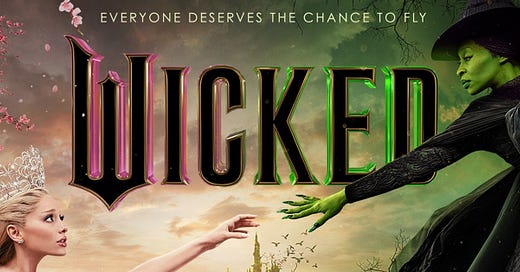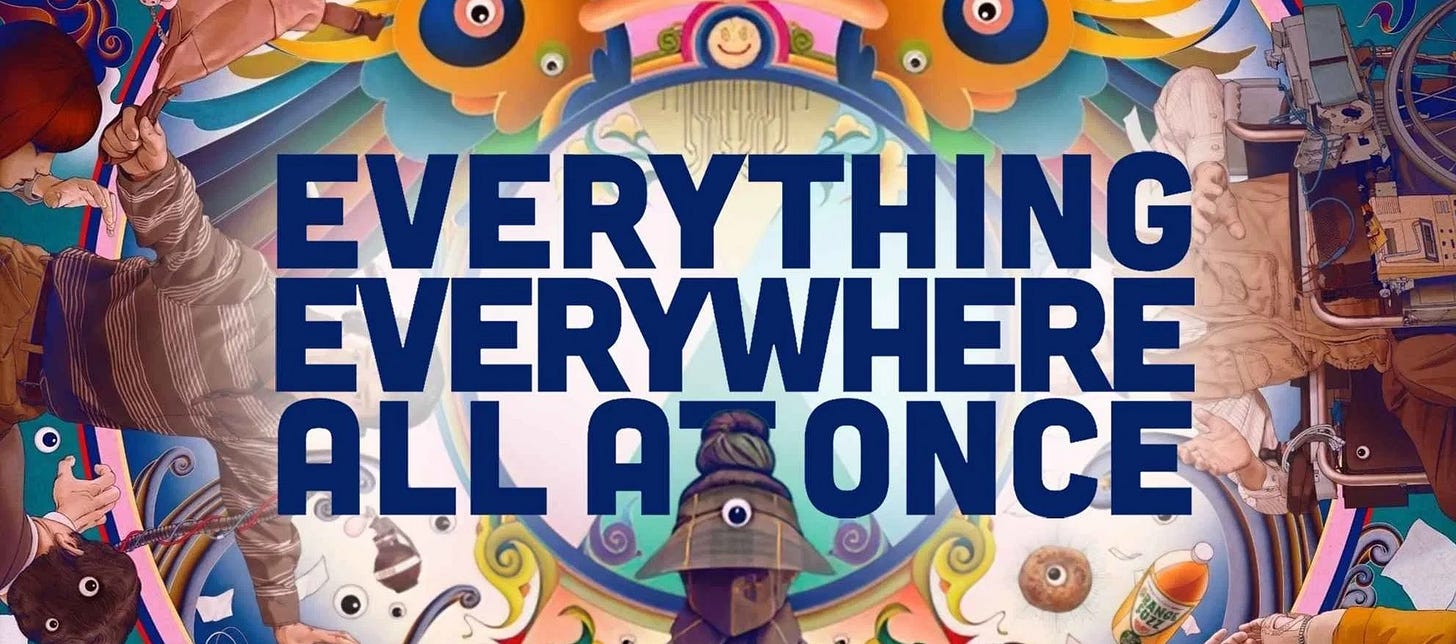Today I want to share a core marketing concept I reference a lot with my personal consulting clients and at Chief Detective. It’s called Symphony Marketing. Whether you’re growing a small company, a big company, or just building your own audience as an influencer — Symphony Marketing is a rich tool that you can start using immediately to build awareness, grow your audience, and get people primed to purchase.
So, let’s get into it.
Symphony Marketing is a “concentrated strike” awareness and purchase-priming tactic where you saturate marketing to your target customer across every possible channel to make it seem like you’re everywhere they turn (at least 3 simultaneous touchpoints).
This kind of marketing is key in the entertainment industry. I actually coined the term Symphony Marketing from reading this article about Universal Studios and the insane marketing attack they did for the movie Wicked Part I. First I'll give you the Wicked example, and then I'll tell you how to apply this to your own business.
A Wicked Phenomenon
The movie industry has a problem, which is that nobody watches movies in theaters anymore. So one of their primary marketing goals is to get butts back in seats in theaters. And at this point, in order to get people to physically go see a movie, the studio marketing teams have to turn the movie into a lifestyle event or a “movement” that becomes a worldwide cultural phenomenon everybody wants to take part in - not by streaming it, but by going to see it in the theater. Think of how much the Barbie movie hijacked culture. It was everywhere. Or the Taylor Swift Eras tour, which created such cultural FOMO, you had to physically go see it live.
Symphony Marketing is a tactic the studios use for promoting their big movies and creating ubiquitous cultural momentum, which is exactly what they did with the Wicked release. Universal knew that Wicked was going to crush and they wanted to maximize it by milking every possible touchpoint of their global media empire to get Wicked surrounding us and popping up everywhere in our lives. That’s why I called this strategy Symphony Marketing.
It’s an orchestration using every possible asset of your company to draw the consumer’s attention to a single product at the same time.
Let’s look at some examples of how they did this:
Universal owns NBC, which was airing the Olympics. When Simone Biles was up on the high beam, the commentators would be instructed to say that she was “defying gravity” and they would play the song “Defying Gravity” while she was competing. (OMG!)
They did a partnership with Amazon, and you could choose between Elphaba or Glinda as your Alexa voice.
They did collabs with Starbucks for special Elphaba and Glinda drinks.
They were in the Macy’s Thanksgiving Day Parade, the Bloomingdales Christmas windows, the Today Show celebrated “Wicked Week,” and Ariana Grande hosted SNL.
The stars of the movie would get photographed in the colors of green and pink, which drove a meme around Elphaba vs Glinda and pink vs. green. (My 12-year-old daughter and her friends obsessed about which pink or green outfits to wear to the movie.)
For the stretch of time leading up to the movie release and for a handful of weeks after the release, Wicked was literally everywhere in our lives.
Surround-sound marketing.
And with all of this they accomplished something extraordinary — they got butts in seats and got people to go to the theater in droves because if you didn’t see Wicked in the theater, you were missing out on the cultural moment. Wicked drove almost $800m in global box office receipts. It was the 3rd highest grossing movie in the US in 2024 and was a massive global success.
The First Principles of Symphony Marketing
Now of course, most of us aren’t running worldwide media empires, nor do we have the ability to just breeze into Amazon or Starbucks and strike global partnership deals. HOWEVER, no matter how big or small you are, applying the concept of Symphony Marketing to your business is critical. It truly does apply to you, and it’s something you have to be doing at important moments.
So let’s break down the 1st Principles, or core conceptual lessons, of Symphony Marketing, and how you can put them to work in your business:
Star Marketing — You always want to be laser focused on your highest demand products and build your marketing around those. Build around your star products. Build around the most successful aspects of your business. The studios only do this for the movies they know have the potential to be huge. Universal knew they had a “holy grail” in Wicked, and it was a company-wide priority to maximize it. So point 1 is to know your stars and be ready to Symphony Market them.
Concentrated-Strike — It is super impactful to do lots of things at once, across all of your touchpoints as a company, and with your outside partners. Again, Universal made Wicked a company-wide priority. They embraced the art of what James Clear called, in regards to his own Atomic Habits book launch strategy, “the concentrated strike” — the power of doing everything all at the same time.
Look out across your year. What opportunities do you have to build up big concentrated -trike marketing moments? It might be an important new product launch, or a best-seller coming back in stock, or an event or a partnership, or some kind of seasonal tie-in. You have to tentpole your year with big moments. If you don’t naturally have those obvious big moments in whatever you’re doing, then you need to manufacture them. You need to have some excuse to do a ton of marketing all at once and seemingly pop up everywhere at the same time.
Now why does this type of concentrated strike marketing work?The Illusion of Velocity — You want to create the illusion of being everywhere at once. If people see a brand or product popping up everywhere, it increases their likelihood to buy it or their desire to be attached to it because of a phenomenon called “social proof.” If you walk past two restaurants and one has a line out the door and the other one is empty, which one do you want to go to? The busy one, of course, because you assume that it’s better, simply because it’s busier. Symphony Marketing has that same effect. When people see you everywhere at once, they automatically trust you and assume you’re legit and good, and they are more likely to purchase or follow you or take whatever action you want them to take because there is automatic trust and preference built into seeing you everywhere.
Ubiquity Marketing / Truman Show Marketing — It’s all about SURROUNDING YOUR CUSTOMER. To build market share, people have to know who you are, and you’ve got to stay top of mind with them. “Awareness” is so unbelievably important in marketing, and so few growth-stage companies ever even use this word, much less have awareness as a committed pillar of their marketing efforts. You need to define your target customer, your #1 audience or buying segment, and list out on a piece of paper:
How old they are, where they live, where they shop and run errands, where they go on vacation, where they own a second home, what other brands they buy, which influencers they follow, etc. etc. etc.
This is your war map. Then figure out how to insert yourself into their path in at least three different ways — to use your integrated marketing to orchestrate a simultaneous 3-point-insertion into your customers’ lives. It could be wholesale distribution points, partnerships, press placements, print ads, billboards, flyers — however you can afford to get in their path at least three times. If you don’t have a huge budget, then you need to be creative. This isn’t necessarily a budget thing. Use grassroots thinking to get in their path at least 3 simultaneous times.
Wearing Down the Needle of Resistance
One of my first jobs was in software sales selling multi-million-dollar contracts. And my mentor would always say, “If I meet with someone in person six times, I’ve got the deal.” So maybe six touchpoints is the ultimate goal, but you can start with three, all in the same breath, so that you are building up awareness and trust by being seen repetitively, in roughly the same stretch of time. The goal is to create a sense of, “oh, I'm seeing them everywhere now.” With every sequential touchpoint you are wearing down their needle to purchase or take whatever action you want them to take. Most people have this needle of resistance to trying new things — and repetitive exposure is often what wears that down.
Applying Symphony Marketing to Your Business
So here’s your homework for doing Symphony Marketing on your business this week:
Pick a new product launch moment or some other excuse to do a bunch of marketing at once around a specific moment in time to drive repetitive awareness touchpoints.
Draw out a war map for your top customer or audience segment in terms of touchpoints in their daily existence — where they shop, things they read, people they follow, or whatever else.
Map out your 3-point-insertion awareness strategy. Insert yourself into at least three of those touchpoints. Surround that audience at that concentrated strike marketing moment, and be everywhere at once for that customer. In other words, use that moment to do Symphony Marketing to surround that customer segment and build up awareness and attachment. Make sure you map out and use every touchpoint that you “own” as a business or person (your social handles, your email/SMS, your ads, etc.) — and then extend into touchpoints you don’t own but you can buy or borrow.
I would try to do Symphony Marketing at least four times a year. Four reasons or moments a year to execute marketing across all of your own marketing channels, as well as partner touchpoints to surround your core audience and be everywhere all at once with a single message.
There you have it — Symphony Marketing — a strategy for aggressively building awareness with your target audience and getting them excited and primed to purchase your product. It just works.
As always, good luck!
Emily
P.S. You can watch a video version of this post on YouTube.





